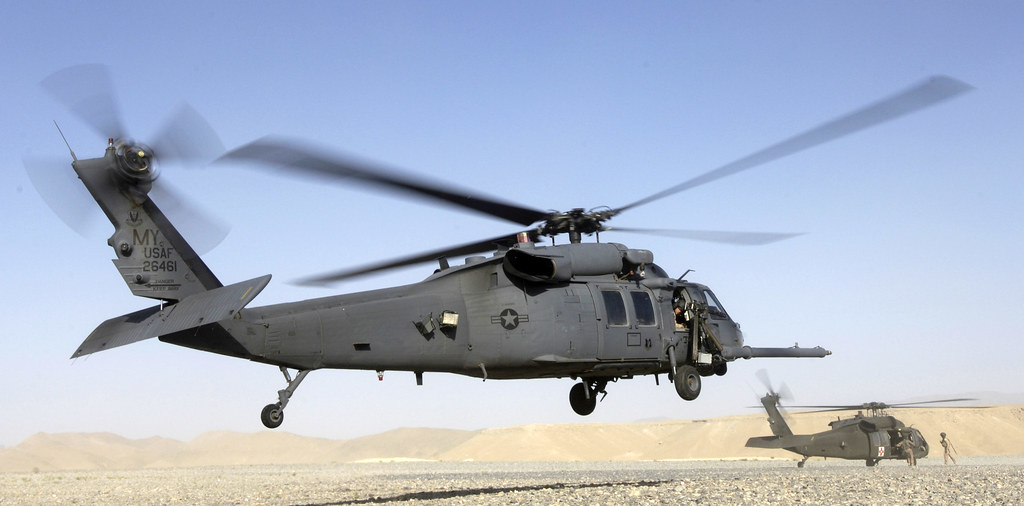
Описание: An HH-60 Pavehawk helicopter lands as a UH-60G Blackhawk prepares to pick up a medivac patient June 13, 2006. The Pavehawk is part of the 41st Expeditionary Rescue Squadron in Kandahar, Afghanistan. The squadron is the first squadron to combine rescue and medivac missions into the same squadron. Mission The primary mission of the HH-60G Pave Hawk helicopter is to conduct day or night personnel recovery operations into hostile environments to recover isolated personnel during war. The HH-60G is also tasked to perform military operations other than war, including civil search and rescue, medical evacuation, disaster response, humanitarian assistance, security cooperation/aviation advisory, NASA space flight support, and rescue command and control. Features The Pave Hawk is a highly modified version of the Army Black Hawk helicopter which features an upgraded communications and navigation suite that includes integrated inertial navigation/global positioning/Doppler navigation systems, satellite communications, secure voice, and Have Quick communications. All HH-60Gs have an automatic flight control system, night vision goggles with lighting and forward looking infrared system that greatly enhances night low-level operations. Additionally, Pave Hawks have color weather radar and an engine/rotor blade anti-ice system that gives the HH-60G an adverse weather capability. Pave Hawk mission equipment includes a retractable in-flight refueling probe, internal auxiliary fuel tanks, two crew-served 7.62mm or .50 caliber machineguns, and an 8,000-pound (3,600 kilograms) capacity cargo hook. To improve air transportability and shipboard operations, all HH-60Gs have folding rotor blades. Pave Hawk combat enhancements include a radar warning receiver, infrared jammer and a flare/chaff countermeasure dispensing system. HH-60G rescue equipment includes a hoist capable of lifting a 600-pound load (270 kilograms) from a hover height of 200 feet (60.7 meters), and a personnel locating system that is compatible with the PRC-112 survival radio and provides range and bearing information to a survivor's location. Pave Hawks are equipped with an over-the-horizon tactical data receiver that is capable of receiving near real-time mission update information. Background The Pave Hawk is a twin-engine medium-lift helicopter operated by Air Combat Command, Pacific Air Forces, Air Education and Training Command, U.S. Air Forces in Europe, Air National Guard and Air Force Reserve Command. Pave Hawks have a long history of use in contingencies, starting in Operation Just Cause. During Operation Desert Storm they provided combat search and rescue coverage for coalition forces in western Iraq, coastal Kuwait, the Persian Gulf and Saudi Arabia. They also provided emergency evacuation coverage for U.S. Navy SEAL teams penetrating the Kuwaiti coast before the invasion. During Operation Allied Force, Pave Hawks provided continuous combat search and rescue coverage for NATO air forces, and successfully recovered two Air Force pilots who were isolated behind enemy lines. In the aircraft's humanitarian relief missions, three Pave Hawks deployed in March 2000 to Mozambique, Africa, to support international flood relief operations. The HH-60s flew 240 missions in 17 days and delivered more than 160 tons of humanitarian relief supplies. After Hurricane Katrina in September 2005, more than 20 active-duty, Reserve, and National Guard Pave Hawks were deployed to Jackson, Miss., in support of recovery operations in New Orleans and surrounding areas. Pave Hawk crews flew 24-hour operations for nearly a month, saving more than 4,300 Americans from the post-hurricane devastation. Within 24 hours of the earthquake and tsunami in Japan, HH-60Gs deployed to support Operation Tomodachi providing search and rescue capability to the disaster relieve Today, Pave Hawks continue to deploy in support of operations in Afghanistan, Iraq and Libya. HH-60 crews have aided hundreds of American, coalition, and foreign-national personnel by conducting personnel recovery and medical evacuations or MEDEVAC missions under low visibility, low illumination conditions at all altitudes.
Tags:
Поиск и фотоизображения предоставлены компанией Flickr с помощью сервиса Flickr API согласно Правилам пользования сайтом Flick.com и его сервисами. Графические изображения являются публичными, размещёнными их авторами в свободный доступ (Public) и физически расположены на серверах Flickr. Все права на фотографии принадлежат их авторам согласно пользовательскому соглашению сервиса Flickr.com и охраняются законами, регулирующими авторские права.